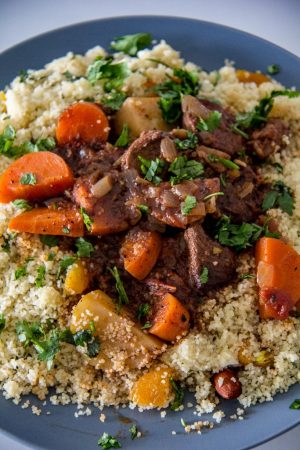 Looking for an authentic Moroccan couscous recipe? Try our Moroccan lamb couscous, just full of the exotic flavors of Morocco. Lamb and couscous are a perfect union. The lamb, vegetables and spices gently simmer away as you prepare and cook your Moroccan style couscous, complete with dried fruits, nuts and fresh herbs.
Looking for an authentic Moroccan couscous recipe? Try our Moroccan lamb couscous, just full of the exotic flavors of Morocco. Lamb and couscous are a perfect union. The lamb, vegetables and spices gently simmer away as you prepare and cook your Moroccan style couscous, complete with dried fruits, nuts and fresh herbs.
There are a number of ways to prepare couscous, ranging from the quick instant in a packet varieties to traditional, using a couscousiere, to hand made from scratch, fresh couscous. Who knew? Which method do you think they use in Morocco?
I suspect most restaurants in Morocco, for convenience use a coucousiere to cook their dried couscous, but it’s a different story in the Berber family we visited. I can tell you from first-hand experience that many families throughout Morocco, still prefer to make their couscous from scratch. This can take anywhere from two to four hours. And, as a bonus, we have a video of hand-made couscous being prepared at home in a Berber kitchen. Make sure you watch it as the film is quite startling!
But before we get to that, what is couscous made from and is it good for you?
What is Couscous?
Couscous is simply ground semolina flour mixed with water and rolled to form grains or pellets. There are 3 major varieties, Moroccan, Israeli and Lebanese.
Moroccan couscous is what most of us are familiar with. In a commercial operation, these tiny couscous grains, are actually ground semolina which is moistened and then machine-rolled with flour to produce the tiny couscous grains. The product is then dried and packaged. You can also make fresh couscous from scratch at home, refer below.
Israeli couscous is often called Israeli pearl couscous or ptitm. It is larger in size than Moroccan couscous, about a third of the size of a pea. It takes longer to cook than Moroccan couscous. Proving again that necessity is the mother of invention, Israel developed couscous because of a severe shortage of rice in the 1960’s which was a common part of the Israeli diet at the time.
PLANNING AN UPCOMING
DINNER PARTY?
Get a FREE copy of the ITALIAN
DINNER PARTY MENU, complete with recipes!
Lebanese couscous is larger again and more the size of a pea or small pellet. It also needs to cook for a longer duration than Moroccan couscous.
Regardless of which variety you eat, is couscous good for you?
Well it is fat-free and sugar-free but it is clearly not gluten-free (if that is a problem for you). It’s an excellent source of selenium and if it is a variety made from durum (whole) wheat (most are not) then it contains some fibre as well.
There is nothing inherently bad about couscous, except that it does have a higher glycemic index than alternatives like brown rice or bulgur. You can read more about health aspects of couscous here.
Traditional Couscous versus Instant Couscous
Until somewhat recently, making couscous at home required the use of a couscousiere, which is somewhat similar to a set of steamer pots but specifically designed to deal with the small, couscous grains.
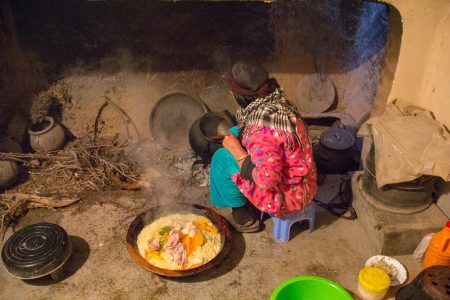 To cook couscous in the traditional way, firstly make sure you purchase non-Instant couscous. Anything you buy from a supermarket is likely to be instant couscous. You can buy the real stuff at Middle Eastern stores where it is usually sold in bulk. You will also need a couscousiere.
To cook couscous in the traditional way, firstly make sure you purchase non-Instant couscous. Anything you buy from a supermarket is likely to be instant couscous. You can buy the real stuff at Middle Eastern stores where it is usually sold in bulk. You will also need a couscousiere.
There is more than one way to cook traditional couscous. The easiest, traditional method is to pour warm water over the dried couscous until it is covered by about 3cm (1 inch). Leave to soak for about 30 minutes until all water has been absorbed. Loosen it with a fork, add salt and some olive oil.
Then it goes into the top part of the couscousiere, where it is steamed by the boiling water in the lower compartment. You can also put vegetables and meat in the bottom half so both cook at the same time. You will need to cook the couscous for somewhere between 30 and 45 minutes, depending on the volume. Test it at the 30-minute mark and then every 15 minutes until it is tender. Once it is tender, fluff it up with a fork and it is ready to serve.
The alternative to the traditional method is to use instant couscous. This usually involves placing the couscous in a saucepan and then just adding hot water to it and allowing it to stand for about 5 minutes. You can add butter or oil at the end. Exact instructions vary depending on the brand, so just follow the instructions on the packet.
To be honest, I have used variations of both these methods and I have found the instant method to be just as good as the traditional method of cooking the couscous. I’m sure you will all be pleased to know that our recipe today for Moroccan lamb couscous employs the instant method!
However, before leaving this topic, there is a third method of preparing couscous and that is to prepare it fresh from scratch!
Making Hand-Made Couscous in a Berber Home
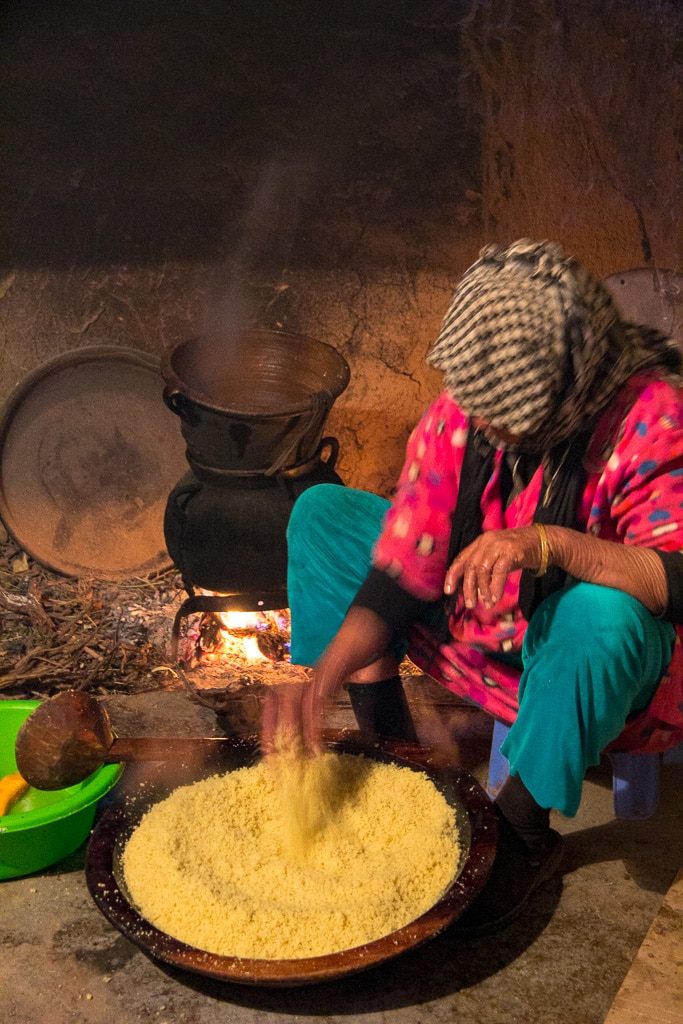 Elizabeth and I had the great pleasure of visiting our guide Abdul’s family home in a village in the Atlas Mountains, where he grew up. We were there to observe Abdul’s mother and sister prepare their own version of Moroccan lamb couscous, together with vegetables. As well, they were preparing a tagine of lamb and vegetables.
Elizabeth and I had the great pleasure of visiting our guide Abdul’s family home in a village in the Atlas Mountains, where he grew up. We were there to observe Abdul’s mother and sister prepare their own version of Moroccan lamb couscous, together with vegetables. As well, they were preparing a tagine of lamb and vegetables.
Luckily for us it was couscous Friday, when many Moroccans celebrate the holy day with couscous, either vegetarian or with lamb and vegetables. The process of making couscous from scratch takes about three to four hours and the result was a richer and maybe more filling couscous than the two dried options described above. The difference is not dissimilar to that between dried pasta and fresh pasta.
You can read how Abdul’s mother prepared the couscous here. And, as promised here is a short video showing Abdul’s mother preparing the couscous. Note the fireplace in the kitchen and how Abdul’s mother uses her hands to fluff up the hot couscous:
The making of the lamb tagine was just as impressive, and you can see a short video by clicking on the link. As an aside, visiting Abdul’s mothers house and hearing about how she lived was just fascinating. Gathering the firewood and water from the community well, milking the cow twice daily, looking after her animals and preparing meals is a complete day. So different to where we come from and how much we take it for granted. We also ate communal style with both the chicken tagine and the Moroccan lamb couscous. It was a lovely experience and we were both full of admiration for this lady, and the Berber people at large.
Moroccan Lamb Couscous
This is a beautifully rich, Moroccan lamb couscous, employing many of the spices for which Morocco is famous. But fear not, as all the ingredients for our Moroccan lamb couscous are easy to purchase. There are two components to the dish.
There is the Moroccan lamb and vegetable stew (tagine) component. Lamb shoulder cubes firstly marinated in spices, then browned, and then stock and vegetables added. Upon reaching a boil, the stew gently simmers away.
When the lamb is stewing you can prepare the ingredients to be added to the couscous. As you all now know how to prepare couscous, it will be prepared using the instant method about 20 minutes before the lamb is ready. Then its just a matter of mixing in the remaining couscous ingredients and you’re all set to serve.
What I love most about this dish is how you can really dress up what is plain couscous with everyday ingredients, so it becomes a visual and taste delight. The contrast of ingredients, some hard, some soft, some sweet, some savory. And, then of course there is the evocative scents of Morocco, you will produce while the lamb gently simmers away.
I hope you enjoy your Moroccan lamb couscous.
Lamb shoulder is one of my favorite cuts of meat and suits slow cooking. Another lovely recipe from Turkey using lamb shoulder is Sultan’s delight, where the lamb is paired with eggplant.
| Servings | Prep Time | Cook Time | Passive Time |
| 6people | 15minutes | 75minutes | 60minutes |
| Servings | Prep Time |
| 6people | 15minutes |
| Cook Time | Passive Time |
| 75minutes | 60minutes |
- Moroccan Lamb Stew
- 2 lbs lamb shoulder cut into 1 inch (3cm) cubes
- 2 tsp cumin, ground
- 1 tsp ginger, powdered
- 1 tsp cinnamon, ground
- 1 tsp salt, ground sea
- 1 tsp black pepper, ground
- 4 tbsp olive oil
- 1 onions finely chopped
- 2 cloves garlic
- 14 oz tomatoes, canned, chopped
- 1 cup beef broth
- 1 bay leaves
- 4 carrots chopped
- 4 potatoes chopped
- Couscous
- 1 lb couscous
- 1 tbsp olive oil
- 3 cups vegetable stock
- 1 cup apricots, dried chopped
- 1/2 cup currants, dried or raisins or combination
- 1/2 cup cheese, feta crunmbled
- 1/2 cup pistachios
- 1/2 cup almonds
- 1/2 cup cilantro (coriander) finely chopped
- 1/4 cup mint, fresh, leaves only chopped
- Garnish
- 2 tbsp cilantro (coriander) finely chopped
|
Ingredients
Servings: people
Units:
|
- In a bowl, add the lamb, cumin, ginger, cinnamon, salt, pepper and 2 tablespoons of the olive oil. Stir well to combine and allow to marinate for 1 hour.
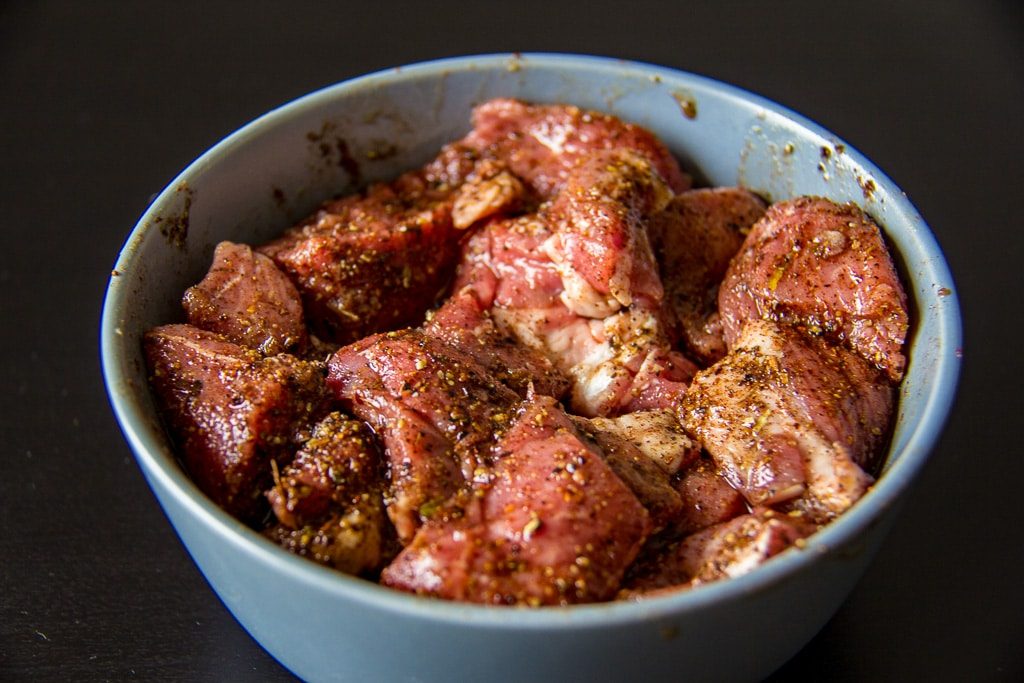
- Heat the remaining 2 tbsp of olive oil in a large, heavy-based saucepan over a moderate to high heat, add the onions and garlic and saute for 2 minutes. Add the marinated lamb in batches and brown all sides. Then add the canned tomatoes and beef broth. When the liquid comes to a boil, add the bay leaf, carrots and potatoes and lower the heat. Simmer for 1 hour.

- While the lamb is simmering, prepare the couscous ingredients.
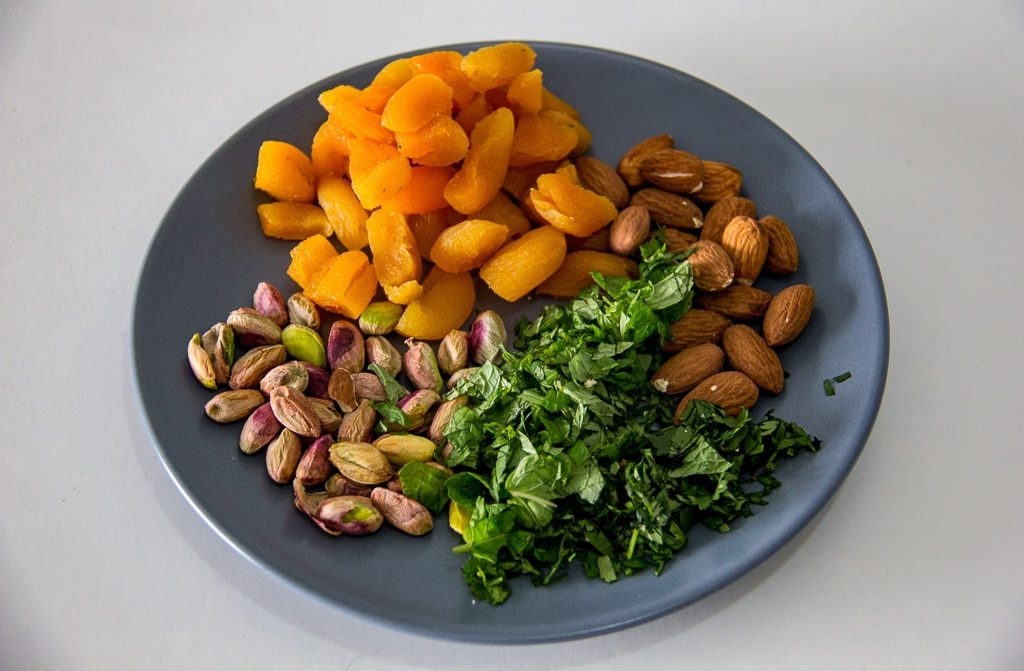
- About 20 minutes before the lamb is ready, rinse the couscous. Bring the vegetable stock to a boil. Add the rinsed couscous. Stir, reduce heat to low, cover with lid and allow to simmer for 5 minutes until most of the liquid has been absorbed. Remove from heat and allow to stand for 10 minutes. Fluff up with a fork.
- Heat the olive oil in a skillet, over a moderate heat. Place the prepared couscous into the skillet. Add the remaining couscous ingredients and stir well to combine.
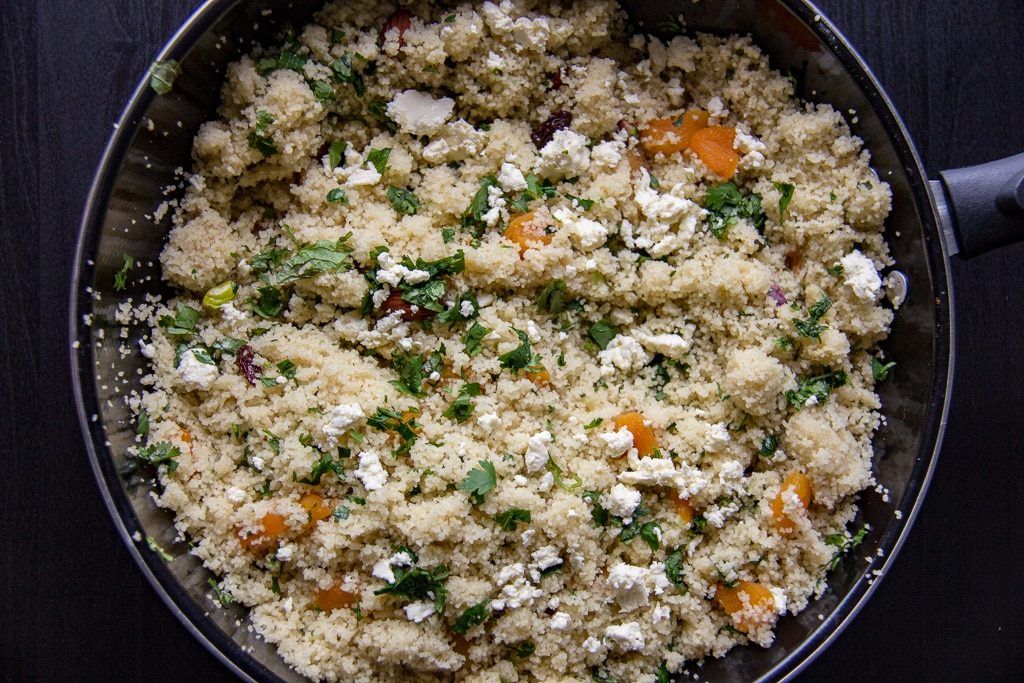
- Serve the couscous immediately onto plates and top with the Moroccan lamb stew and garnish with cilantro.


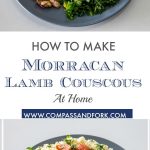
Karen
Just polished this off for lunch and it was so delicious! All those spices make the lamb so tasty and the dried fruit really makes for interesting couscous. No feta though.